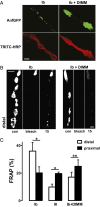Vesicle capture, not delivery, scales up neuropeptide storage in neuroendocrine terminals
- PMID: 24550480
- PMCID: PMC3948302
- DOI: 10.1073/pnas.1322170111
Vesicle capture, not delivery, scales up neuropeptide storage in neuroendocrine terminals
Abstract
Neurons vary in their capacity to produce, store, and release neuropeptides packaged in dense-core vesicles (DCVs). Specifically, neurons used for cotransmission have terminals that contain few DCVs and many small synaptic vesicles, whereas neuroendocrine neuron terminals contain many DCVs. Although the mechanistic basis for presynaptic variation is unknown, past research demonstrated transcriptional control of neuropeptide synthesis suggesting that supply from the soma limits presynaptic neuropeptide accumulation. Here neuropeptide release is shown to scale with presynaptic neuropeptide stores in identified Drosophila cotransmitting and neuroendocrine terminals. However, the dramatic difference in DCV number in these terminals occurs with similar anterograde axonal transport and DCV half-lives. Thus, differences in presynaptic neuropeptide stores are not explained by DCV delivery from the soma or turnover. Instead, greater neuropeptide accumulation in neuroendocrine terminals is promoted by dramatically more efficient presynaptic DCV capture. Greater capture comes with tradeoffs, however, as fewer uncaptured DCVs are available to populate distal boutons and replenish neuropeptide stores following release. Finally, expression of the Dimmed transcription factor in cotransmitting neurons increases presynaptic DCV capture. Therefore, DCV capture in the terminal is genetically controlled and determines neuron-specific variation in peptidergic function.
Keywords: LDCV; nerve terminal; neurotransmission; secretory granule.
Conflict of interest statement
The authors declare no conflict of interest.
Figures




References
-
- Montminy MR, Bilezikjian LM. Binding of a nuclear protein to the cyclic-AMP response element of the somatostatin gene. Nature. 1987;328(6126):175–178. - PubMed
-
- Benveniste RJ, Thor S, Thomas JB, Taghert PH. Cell type-specific regulation of the Drosophila FMRF-NH2 neuropeptide gene by Apterous, a LIM homeodomain transcription factor. Development. 1998;125(23):4757–4765. - PubMed
-
- Allan DW, Park D, St Pierre SE, Taghert PH, Thor S. Regulators acting in combinatorial codes also act independently in single differentiating neurons. Neuron. 2005;45(5):689–700. - PubMed
-
- Allan DW, St Pierre SE, Miguel-Aliaga I, Thor S. Specification of neuropeptide cell identity by the integration of retrograde BMP signaling and a combinatorial transcription factor code. Cell. 2003;113(1):73–86. - PubMed
Publication types
MeSH terms
Substances
Grants and funding
LinkOut - more resources
Full Text Sources
Other Literature Sources
Molecular Biology Databases
Miscellaneous

